|
Last week I opened with a map of the U.S. It was virtually all red, indicating the extent of the coronavirus infection is severe and is nationwide. Things have only gotten worse over the past week. This week I’m opening with this graph. It shows how Arizona’s weekly average of infections has trended. Up. Quickly.
 The Governor issued Shelter-in-Place orders when the COVID numbers were about 25% of what they are now. Today he says, “Arizona is open for business.”
And do you remember Rt? It’s the infection rate. If it’s below 1, sick people are not spreading the disease. If it’s above 1, they are. Here’s how Arizona has trended, with a notation showing where the Ducey shelter in place order began and ended:
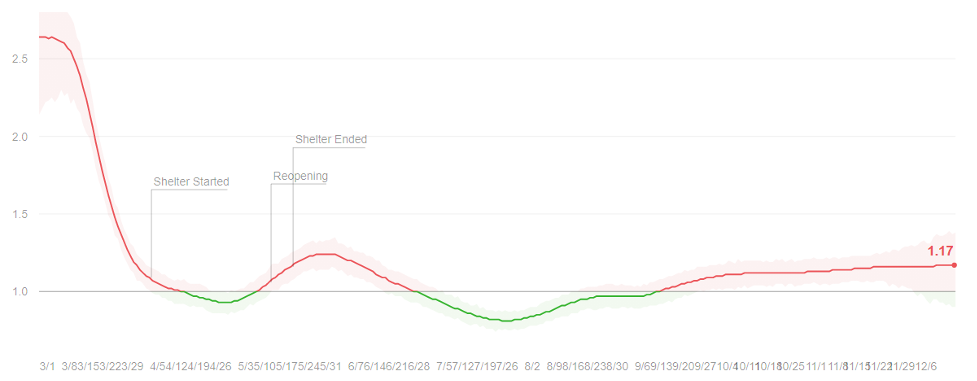
The last time the Rt was at or below 1 was September 8th. That was about the same time I began advocating the UA make testing of all students taking classes mandatory. They didn’t. It would have been responsible public health policy.
The responsibility for turning this around is on us. Please consider the graphic reality of what’s happening as you continue through the newsletter.
Blue Light Recognition

Each week at some point in this newsletter, I mention that the health care ‘system’ being stressed is really a comment on the people working in those institutions being stressed. Hospital bed capacity is nearly maxed out, but while we can always find a bed, we cannot always find trained and fresh staff to do the work the patients need bedside.
|

This week’s blue light recognition is for the Medical Reserve Corps of Southern Arizona (MRCSA.) This is a group comprised of just what the name implies; licensed health care personnel, including retired workers and students in healthcare career tracks. They’ve been stepping up and giving relief to our paid workers as this pandemic expands.
Last week I was able to connect retired nurse Nancy with MRCSA. She’s going to help administer vaccines when they become available. Confession – I would not want to give someone a shot. I’m happy to leave that up to Nancy. But MRCSA is affiliated with health organizations of all sorts. Volunteers include of course nurses and docs, but also pharmacists, chiropractors, behavioral health professionals, dentists, and even veterinarians. If you’re in a licensed medical field, think about pitching in.
Certainly, the roles MRCSA needs right now are going to largely be COVID-related. But you can check out the organization generally by going to www.mrcsa.org. There’s a short introductory application you’ll find on that site to get yourself started.
Thanks to Nancy and to Mary from MRCSA for connecting us. And thanks to all of the volunteers who are getting involved to help relieve the strain COVID is placing on the people working the front lines of the pandemic.
|
Guns and COVID
Between March and November of this year, according to data produced by Moms Demand Action for Gun Sense, there were 43% more background checks processed than in 2019. And yet, if the check isn’t completed within 3 business days, the gun sale is allowed to go through. That’s what happened in the Charleston church killing. Of those 43% more checks, they estimate 600,000 took longer than 3 days.
One more fun fact from my friends at Moms; online posts by people looking to buy a gun with no background check have doubled this year as compared to last year. In Arizona, private person-to-person sales do not require a background check. It’s a loophole in the check system that takes place in our community every day, and multiple times every time the County Fair Commission hosts a gun show out on the Fairgrounds.
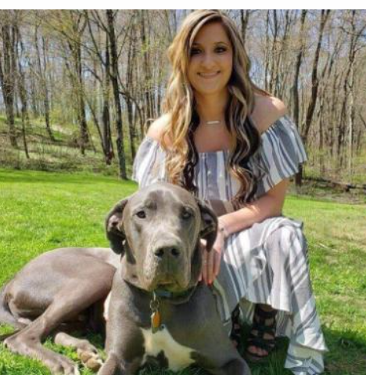
That’s Caitlyn Kaufman and her pup. There are two reasons I’m a fan of hers. One – she's a dog lover. Two, she’s an RN. What’s the connection to this piece? Last week Caitlyn was driving to the COVID unit in the Nashville hospital where she worked when she was gunned down by a random killer. The guy was arrested on Friday of last week when he called in a tip to try to get the $50K reward being offered.
If you’re looking for an end-of-the-year non-profit to support, Moms Demand Action could use your support. You can find them at www.momsdemandaction.org.
|
Eviction Update
In the past week, I’ve gotten several calls about the impending eviction issue. Friend and Constable Joe Ferguson was also contacted and is included in this story by Allie Potter from KVOA. She covered the issue well.
KVOA Tucson News:
An 'Eviction Tsunami' could be on the way to Pima County
There is no way this problem is going away without some change in how it’s being addressed. Last week at our council meeting, we had representatives from Tucson Water, TEP, and Southwest Gas present to talk about what options are available for people who are behind in their utility bills. As I explained to one guy who called on Thursday, this is about more than just rent. People are struggling with rent, mortgages, water, sewer, electricity, gas – and the Federal deadline for the moratorium on evictions is the end of this calendar year. To put it into perspective, TEP right now has over 3,300 customers who are behind in their payments, and the average amount due is roughly $600.
We gave City Manager Ortega direction to work with the utilities and use more of our CARES money to help people with their arrears. But the most immediate need is for the Governor to extend the moratorium and to streamline the application process, so money that’s already sitting in the State account gets out the door and into landlords’ hands.
We keep saying ‘we’ll get through this’, and we will. But the reality is that many thousands of people are facing being out on the street around New Years if the Governor doesn’t affirmatively act. Please write to both him and your State legislative representatives and urge quick action.
Pima County Health Advisory
Last Wednesday, Pima County issued this advisory -
Things have only gotten worse since they issued the alert. This is the State/Pima County chart covering the past week.
New Statewide cases are the 4th column, and new County cases are the last column. That’s 5,755 new cases in Pima County in the past 7 days. That’s more than we had in April, May, June, August, September, or October – the entire month.
Look at the fatalities.
That 109 figure is for less than ½ of the month of December. And we haven’t seen the Thanksgiving peak yet. Seventy of those came in just the past week. This is the ‘surge upon a surge’ that Dr. Anthony Fauchi said to expect based on how people ignored the public health warnings issued ahead of Thanksgiving.
Nobody but me will be in the Ward 6 office this coming week. I’ve told my staff to work completely from home. Please continue calling and emailing. We’re answering all of that, but we are not sharing space in the building. I’ve also let it be known that I won’t be at the in-person Mayor and Council budget meeting this coming Friday. It simply makes no sense.
I’ve written before that we’re all learning as we go. Applying what we’ve learned still appears to be the challenging piece for too many people.
The 5 Biggest COVID Lessons
The Chronicle of Higher Education has been tracking the COVID issue all semester. As the holiday break is upon us, they’ve summarized what public health lessons have been learned by watching outbreaks and responses at Colleges and Universities across the Country. These aren’t going to make you do a double-take in surprise unless you’re one of the people who didn’t feel making testing of off-campus students mandatory was a bad or unconstitutional approach.
Schools spent a lot of money, making sure the classroom environment was clean and safe. Millions of dollars were spent on plexiglass, seat removal, upgrades to ventilation systems. The result was that inside classrooms was not a significant vector for spreading COVID. The small class sizes, along with the other changes to that built environment, meant the few students and faculty who were doing the in-person teaching were not getting sick while in the classroom bubble. That’s one lesson – spend millions on preparing the space, and limit the number of people inside, and you’re relatively safe.
The next lesson is one that even the UA leadership has been aware of, despite not mandating off-campus testing. That is, large social gatherings off-campus are a significant cause of the COVID spread. At the U Illinois-Champaign, there were reports of ‘COVID parties’ where students would intentionally hang out together and try to get sick - ‘to get it over with.’ I heard the same thing was going on here in Tucson. On-campus actions can be great, but when students (and faculty) exit campus and join large groups, that’s where the problems began.
The third lesson is that residence halls are problems. At the UA, they required testing for on-campus dorms. They initially said they had no authority to mandate testing for students living in off-campus settings. That’s not true, and now that the semester is over, they’ve announced a plan to mandate testing for any student taking part in in-person classes, regardless of whether they live on or off-campus. It’s a start – a late start, but one none the less. Apartment complexes, high rises, Greek-letter houses are all congregate settings in which the virus spreads quickly. We saw it. Some Universities reduced occupancy to singles only. But this lesson is intuitive. Put a bunch of people into a close living environment, and the virus will spread. Science sets the rules.
Following on the third lesson is the one the Chronicle reported about testing; that is, both entry testing and repeat surveillance testing are critical to containing outbreaks. This is a quote from the Chronicle’s report: the top-line results are clear: Testing students immediately before they arrive on campus, and then continuing to test asymptomatic students throughout the term, is necessary to identify and deal with outbreaks before they careen out of control.
No mention of pandering to the outside community, and no mention of testing students immediately before they arrive on campus being unconstitutional. It’s just good public health policy. And many schools across the Country adopted those kinds of rules. At Duke, they tested every student at least once per week throughout the semester. They found 51% of the positive cases they uncovered were from students who showed no symptoms. Clemson and Illinois found similar percentages. And they also had mandatory and repeat testing. Corey Klambaugh is an Epidemiology professor at Clemson. He heads up their testing program. His comment to the Chronicle was, “Opening and not testing feels irresponsible to me.” I agree and have been trying to push that position home to the UA all semester. It’s not a unique position throughout the higher education universe.
Pullman, Washington is a rural town that’s home to Washington State University. In September, they experienced a spike in COVID cases that was directly tied to students showing up in the town, even though the majority of the classes being taught at WSU were online. The fifth lesson the Chronicle reported was that College-student outbreaks can lead to infections and fatalities in vulnerable community populations. Those students who became vectors for spread in Pullman would not have been there had it not been for WSU inviting them into the community. The same is true of every College town in the Country. Schools are responsible for the impacts they create. Refer back to lesson #4 – test every student you’re inviting to be a member of the community in which your school resides.
When UA President Robbins sent his #2 guy to speak to the Mayor and Council, and he called my mandatory testing Resolution ‘pandering,’ it showed he hadn’t learned either lesson #4 or lesson #5. Based on the change in what’s planned for the UA in the spring, it appears some learning has taken root. Not enough, but there’s a glimmer to work with.
Sign Code
There are a few issues we deal with that every time they come up we know they’ll generate some heat from varying directions. The sign code is one. Last week we adopted some changes to it, but it’s important to recognize that we kept a sunset date in what we did. It’s 5 years – a pretty long sunset. That’s important primarily because as long as the code changes are not finally etched in stone in the code, and they’re subject to sunsetting, rights don’t vest and become items we can be sued over if we were to later change the terms of the code. That’s a little in the weeds, but it’s an important point. Staff would have preferred we just sign off on the changes, so we don’t have to go through another review ahead of the sunset. Others would have preferred we adopt a shorter sunset so that review happens sooner. What it does is give us a chance to get through COVID, hopefully get back to more normal development times and give us a chance to see how the proposed changes are working.
One other very important piece of the sunset is that it allows the group working on outdoor lighting standards to complete some work they began pre-COVID. That work impacts our astronomy industry, and locking in the terms of the code as they were presented to us would have prematurely cut off their ability to adjust outdoor light standards. Our Dark Skies community is far too important to force them to accept code revisions while they’re still at work testing how they’ll impact the astronomers.
We already have embedded in the code some rules that are there specifically to aid the Dark Skies concerns many of us have. And they’re largely being ignored. Included in our current sign code is the requirement that at certain times of the night, businesses are supposed to either turn off, or dim their signs. There are timers on all electronic signs that can be set to shut it off at say 11 pm. In many cases, we’ve found the timers are either not working, or simply need to be reset. And in some cases, the business owner is unaware of the code requirement.
This chart shows the times of day already in our code that signs are to be shut off:
 The “Lighting Area” is defined in Chapter 3 of our code. It refers to different parts of the City (residential, around Mt. Lemmon, etc.), and the times shown in the chart are when the signs are supposed to be shut off. Enforcing this part of the code will immediately help the astronomy folks.
In the run-up to the vote on the code, several business people, including representatives of the Metro Chamber, said they’d help to get the word out about this illumination curfew. I’m using this newsletter to do the same. We don’t want to be issuing citations, but we do want to see businesses that are currently not complying to begin adhering to the terms of our code.
If you have a business that uses illuminated signage, please check the timer on the sign and compare it to the chart you see above, so you’re sure you’re doing your part to support astronomy in Southern Arizona.
Campbell & 6th Development
It was just over a month ago that the developer proposing a significant new project for the SW corner of Campbell/6thheld a required rezoning meeting with residents. This graphic shows what’s being planned for the corner:
 There are actually 14 different parcels in that footprint that are being combined in a Planned Area Development (PAD.) That’s a tool used to avoid having to rezone each parcel independently. It’s a good tool, but the tool doesn’t define whether or not the project is also ‘good’ for the area.
Right now, people are trying to sort out who the actual players in this are. The developer said the UA has partnered on what it “would like to see developed on that corner.” A representative from the UA indicated they’re not involved at this point. It’s key to know the level of UA engagement if we’re to avoid another ‘Honors College’ development where the UA entered a land deal with a developer and effectively by-passed the City zoning processes. During the Honors College public disagreement, UA President Robbins asked to meet with me about it. He was at that time new to his job and was concerned with the bad optics the process had for the UA. We’ll see if that concern rolls over to this project, allowing the City processes to continue without State interference.
The developer is the same guy who owns O’Malley’s and Bob Dobbs. He doesn’t have the financial capacity to pull off the scale of development being proposed, so some partnerships will be involved. That’s important because student housing is already being discussed as one component (the 140’ tall one) of the project.
For a few years, I’ve been public in saying that if the UA feels there’s a need for more student housing, they should take advantage of the on-campus footprint they have and go vertical within campus. There’s a study UA Housing did that, according to one of their Housing guys, concluded the off-campus student housing is reaching saturation. The UA Housing folks have evidently lobbied Robbins to do what I’ve been suggesting; keep it on campus and upgrade what they have. They presented a report to him over a year ago. When I asked for a copy of it, I was told “this study was designed for use as an internal planning tool and was not prepared for external distribution.” Ok – and I understand COVID will impact their ability to self-fund. I raise the issue here to repeat the message that off-loading student housing into residential areas by the UA is not going to be a continuing process I’ll be supporting.
Based on the response the developer received from the neighborhood group, neither will they. They’ve asked for a height reduction and the elimination of student housing from the project. Among other conditions – but those are the design/development/use conditions that will be front and center when the groups reconnect.
This is a massing diagram of what the project would look like from the south if it was built as proposed. The white blocks in the middle and to the right of the picture show the size of the project. The orange, shorter rectangle in the foreground is the current UA parking garage. The counter-proposal that’s right now on the table is to cap the new project at that height.
 The developer said he’d like to break ground in 2 years. I know the UA President has been advocating for a hotel on that corner. And the UA athletics department thought a student-athlete ‘dorm’ at that location would be nice. You see both of them in the proposed development. The developer said he has been in contact with both UA admin, and athletics. So it’s clear there have been conversations between the parties about this corner. That, despite neighbors having been told by the UA community relations rep, “UA isn’t currently having any conversations with the developer about this project, but should that happen in the future I will let you know. We remain committed to working with the neighborhoods on this potential project.”
Maybe she’s landing on the word “currently.” If so, that’s disingenuous. I’ll continue working to keep this process in the light of day.
Local Tucson

This week’s Local Tucson item is another ‘two-fer’. One is coming this Thursday over at the Randolph Center, 200 N. Alvernon. It’s the east end of Reid Park. And this Thursday, from 4:30 until 6:30, the kids will have a chance to get an early Santa sighting. It’s all COVID safe – Santa will be inside of a giant snow globe. And I’m told that from 4:30 until 5:30, Santa might bear a strong resemblance to me. Suited up and stuffed, of course, but if you bring the kids by, don’t ‘out’ me.
This will be a drive-thru event. It’s actually happening in each Ward, and this Thursday is our turn to host – and participate. You’ll receive a goodie bag full of holiday stuff, including arts and craft kits, holiday trinkets, and of course something to boost the kids’ sugar levels just in time for dinner. ‘Santa’ will be waving from inside the globe a safe distance from everyone, but close enough so the kids will get a hint the season is about to arrive.
Thanks to our partner at Parks and Rec, Dawnee, and her team for organizing this. Cookies with Santa is our way of maybe changing focus from all the tough stuff we’re facing and bringing some happiness to the kids – at least for a while. Here’s the full schedule for all 6 of these events. I hope to see you – from inside the globe – this Thursday.
|
 |
The other part of the Local Tucson is Rae’s Place. They’re one of the downtown businesses that are struggling and need your support. Due to the COVID infection spike, the County is considering going to an employee ‘stay at home’ policy for their workers. Right now, Rae’s, as well as all of our downtown businesses, rely to a large degree on the government employees who work in the area for daytime business. If they’re sent home, that means more hardship for the businesses.
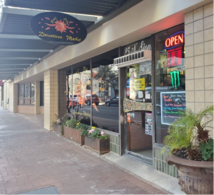
Rae’s is located at 25 N. Stone, at Broadway. They have taken out of snacks, food, groceries, and a bunch more. If you’re looking for ways to help our downtown businesses survive COVID, here’s another one you can add to the list. Find them at https://www.yelp.com/biz/raes-place-tucson.
|
Sunshine Mile Overlay Hearing
This Thursday is also the night of the Sunshine Mile Overlay Zoning Examiner hearing. Santa will be making a shift change in order to join that meeting at 6 pm. You can too by going to www.tucsonaz.gov/pdsd/zoning-examiner, and clicking on ‘Join Meeting.’
This is the next step in hopefully creating a sense of place along the Sunshine Mile. That’s the stretch of Broadway you now see under construction – from Euclid to Country Club. And it’s the stretch that many of us fought to find a better solution than simply investing $76M in making it wider. Thanks to the advocacy many of you have invested in the process and to Rio Nuevo for stepping up and working with Project for Public Spaces (PPS) and the public, we’re now close to seeing lemonade.
Here’s a little history – the RTA vote of 2006 included widening Broadway to 150’ and 8 lanes. The voters were told that traffic counts validated the need for the widening. The traffic counts were both dated and incorrect. There is no need for creating a freeway for those 2 miles in the approach to the pinched down entry into downtown.
The Mayor and Council, on another 5-1 vote, approved a somewhat scaled-down version of the widening. Now it’s closer to 125’ wide and is 6 travel lanes. The Sunshine Mile Overlay is an attempt to preserve many of the historic buildings that won’t be demolished in the widening, and also to put into place conditions that will allow development that’s neighborhood scaled, destinations you’ll be able to arrive at safely by foot, bike, or by car. Rio Nuevo hired internationally known PPS to work with the public and come up with design standards aimed at achieving that goal. Here’s a rendering I’ve shared before. It speaks to the intent of the Overlay:
Join in on the 17th. This has been a long journey. I’m hopeful we’re close to salvaging something lasting and good for the entire region. And in the process, set a template for future development along our arterials that embraces something other than facilitating driving past our local businesses.
PFAS Update
I had a good meeting with our D.C. team on Friday. We periodically review our legislative priorities with them. When asked what my top ones are, I said an immediate COVID relief package for businesses and families, PFAS legislation that puts dollars into our hands for remediation of the plume we’re working on and reversing the evisceration of the EPA that has taken place under Trump. I’m moving our PFAS item forward locally with an upcoming informational/educational meeting.
The DOD used fire fighting foam on base that has resulted in the contamination of water wells in the immediate vicinity of DMAFB. The red hashed line arc shows where the known contamination is. On the map, you see blue dots. Those are our active water wells in midtown. We monitor them regularly to assure the water continues to be clean. Where we have found PFAS over 18 parts per trillion, we’ve shut down the wells. Those are shown as the red dots.
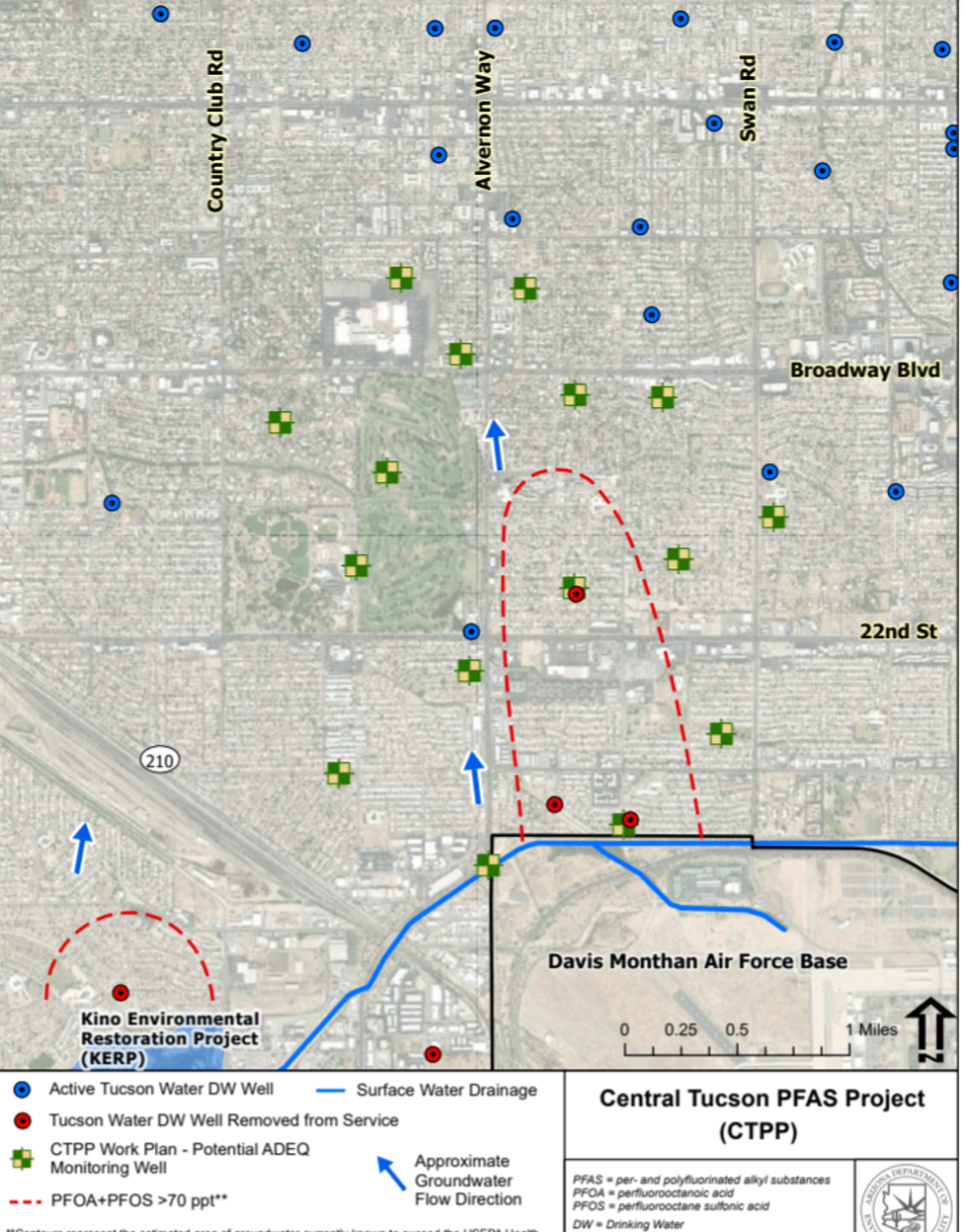 We’re working with the Arizona Department of Environmental Quality (ADEQ) on finding the full extent of the contaminants. The State just last week allocated just over $3M as a part of this study. The goal is to outline the plume, capture it, build treatment plants, and eventually to replace our lost pumping capacity by drilling new wells. The full cost of all of this should belong to the Department of Defense, and to the manufacturers who put the foam onto the market, despite knowing it was toxic. We’re fighting in court against 3M and other manufacturers and are working to get DOD to the table with a checkbook in hand to pay for the work we’re already doing.
So far, we’ve had to shut down 18 wells. That’s 10% of our total system. The good news is that we’re not reliant on serving groundwater. We serve the Central Arizona Project (CAP) water from the Colorado River. But that’s not an endless source. We must protect and preserve our groundwater. That’s what this is all about.
More on this as the meeting gets closer. Aside from COVID-related issues, it’s my number 1 topic of concern for the region.
UA Briefing
There was another UA COVID press briefing last week. It was nice to hear the UA President affirm that ‘off-campus behavior has a direct affect on the success of addressing COVID.’ And it was nice to see they’re planning on adopting some of the measures ASU has had in effect, that I’ve been advocating for, and that until now, the UA has resisted. Until now, it wasn’t constitutional.
Beginning in January, the UA is planning on requiring weekly testing for all students, either living on campus, or taking in-person classes. In fact, Robbins said, ‘any student visiting campus.’ That’s the ASU model. Better late than never.
I’ve reported in the past that at ASU, if you don’t provide proof of having been tested within 48 hours of being pinged by their health folks, you’ll hear from the Dean of Students. And if you fail to take part in their Wellness Check, they’ll shut down your access to school accounts. The UA is now planning on shutting down access to school WiFi if you don’t test. The students need that in order to take classes. I certainly wish this level of conversation had taken place prior to them eliminating my job over my having pushed for a mandatory testing Resolution.
There’s more. The required test will be the PCR test, not the quick antigen test they’ve been using as a screening tool. In an earlier newsletter, I pointed out that the quick antigen testing is not recommended as a screening tool for asymptomatic people. And yet, that’s how it was being used by the UA. Not in January though. Again, this could have been a good conversation topic a couple of months ago. I’m glad to see they’re following science now. Oh, and faculty and staff will also be under the WiFi mandate. That's also good. Everyone who visits campus travels back out into the community.
They of course, won’t be able to mandate testing for vendors and delivery people visiting campus. One of the reasons I pushed for mandatory testing, even for the kids living in the off-campus apartments, was that they’re in regular touch with vendors, including people such as Uber drivers. That contact screams of community spread. The UA is still not planning on extending the mandatory tests to all students, even those studying through virtual classes. That’s a remaining hole in their plan.
Here’s the graphic they showed during the press briefing. It’s a week old now. Conditions have further deteriorated.
Robbins also wants to mandate that anybody coming onto campus be vaccinated. That’s a long way off. Baby steps – as the numbers escalate.
Meanwhile, in the NCAA sports world, this comment from the head basketball coach at Pitt:
“These kids are away from their families, and they’re out and they’re laying it on the line to entertain people. Something just doesn’t feel right about it right now. The numbers were what they were back in March. I look at it every day, man. It seems like every day it’s getting worse. I don’t know why you cancel it in March, but you say it’s OK to do it right now. But what do I know? One of the things that has come about with all of this since everything happened in March when the season was canceled, I don’t think anyone can say anymore that these young men are amateurs. That’s out the window. They’re not. They absolutely aren’t.”
That’s spoken by a guy whose livelihood is on the line for speaking out. Mine was too. If there’s a place in the universe where a robust free flow of ideas should be embraced, it’s a University campus. I wish Coach Capel well.
And this side note on the weekend firing of UA football coach Sumlin. He was fired by the guy whose name is all over his hiring 3 years ago, Athletics Director Heeke. The UA will now pay Sumlin roughly $7M to not be the Wildcats’ coach for the next 2 years. Pretty good gig if you can get it. UA would do well to find someone, both as head coach, and as AD who has a long-term commitment to this community, roots in our program, and isn’t demanding (and being given) a contract that leaves millions due if he fails to perform.
The COVID Tracking Project
Last week the COVID Tracking Project data showed us having increased 11.2% in hospitalizations from the previous week. It’s worse this week. Here’s a graphic I pulled from their site over the weekend:
 Now we’re 19% above where we were last week. The trend is about to crash the health care system. That means health care workers. And yes, those hospital cases are serious. That same site has this graphic showing a 20% increase in fatalities in Arizona over the previous week. I had those raw data up at the beginning of the newsletter. This shows we’re among 27 States with rising death numbers.
I can display the severity of our COVID situation in any number of ways. And I do, each week. More below – the message continues to be that if you don’t follow the public health recommendations, you’re placing you own, and others’ lives at risk.
Be Kind
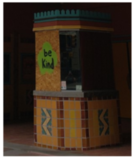
This week’s Be Kind is for a friend and former Sacred Space participant, Diane. On our one (thankfully) rainy and chilly night last week, she called and asked if I could help get 4 migrants to shelter.
Diane lives pretty far out west of town. It’s not uncommon for migrants to wander onto her property. She and her partner took in this group of 4, and working with me and others, we were able to get them some direction to next of kin. Two years ago, they’d have been our guests at the Benedictine. From there, they’d have been connected with family and given help understanding the legal process they face as asylum seekers. Now that work is being done by Catholic Community Services (CCS) out at the Alitas Center in the County facility. But Diane stepped towards the need and helped these guys with that connection.
CCS is taking in migrants daily out at Alitas. The needs continue. Thanks to Deb from Rincon Heights for continuing the collection of the hygiene products we’re taking in at Ward 6 for these families. And thanks to Diane for helping 2 guys from Honduras, and 2 guys from Guatemala come in out of the rain and cold and get onto their families in other States. If you volunteered at the Benedictine, you know their stories. The need didn’t stop when the construction began over there.
|
Youth On Their Own

To say this is going to be a unique holiday season would be stating the obvious. The folks over at Youth On Their Own (YOTO) are continuing their supportive work, and now have the help of two community partners. You can join in the work and see your participation doubled.
In the past, YOTO gifts the youth in their program with gift cards and blankets during this time of year. This year the needs are even more vast. I began with a section on the eviction problem many are having. YOTO is working to keep homeless youth in school, and in stable environments. This year that’s happening with an $80 gift to each of their students. The partners are matching donations, up to a total of $50K to help touch as many kids as possible.
‘Buzz’ Peterson and Robbie Willingham are the Santas who have offered the matching gift. They’re serving over 2,000 youth this holiday season. If you’re so inclined, you can join ‘Buzz’ and Robbie by checking out YOTO at www.yoto.org. On that site, you’ll see all the great work that’s being done. And how you can be a part of keeping a kid in school – an even more daunting task this year as homeless, couch-surfing kids try to hold it together while ‘school’ is anything but normal.
|
Glass Recycling/Reusing
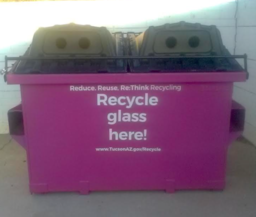
When you bring your bottles to the Ward 6 office, now you’ll see this contraption out in the back. Please feed it. I’ve told our Environmental Services folks that I think you’ll fill it up in just a few days. I’m expecting we’ll need a larger one, but we’ll see how things go.
The City is ordering a commercial scale crusher that will be in operation when the City-wide program fully goes into effect. I suggested (begged) they get me one of these so they can begin to compile a stock of glass that’ll be on hand when the new larger crusher arrives. When that program rolls out, you’ll find these at 22 different locations around the City. I’ll be sure to write more on this as we get closer to that date. Until then, keep bringing your glass by – just toss it into the bin instead of leaving it stacked on the ground outside the garage.
|
COVID Trends in Arizona
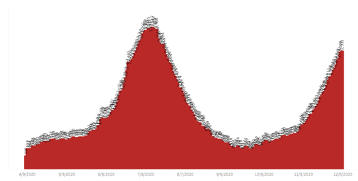
Last week I shared the graphic from the AzDHS website showing hospitalizations. In the past week, things didn’t get any better. This is the hospitalization graphic for this week – still clearly headed in the wrong direction.
But there’s a subset of that in-patient graphic that speaks to the severity of the cases. Look at how today’s number for intubations compares to our mid-summer peak:
|
In September and October, some of the medical people were saying that we’re treating people more effectively, so fewer are getting severely sick. Now the numbers are simply overwhelming, and despite the level of treatment, the ventilator data is headed back up again. And we have not seen the peak from the Thanksgiving activity.
I’ll keep this March COVID map in for a while longer. It shows where we were when Ducey implemented his Shelter-in-Place Executive Order.
With that, compare the March map (above) with today’s (below):
No change in the Harvard Global Health picture of Arizona. Everyplace in the State is still in the Red risk category, which calls for a shelter-in-place protocol. Governor Ducey will not be implementing anything like that, any time soon. That shifts the burden to each of us to practice safe behaviors.
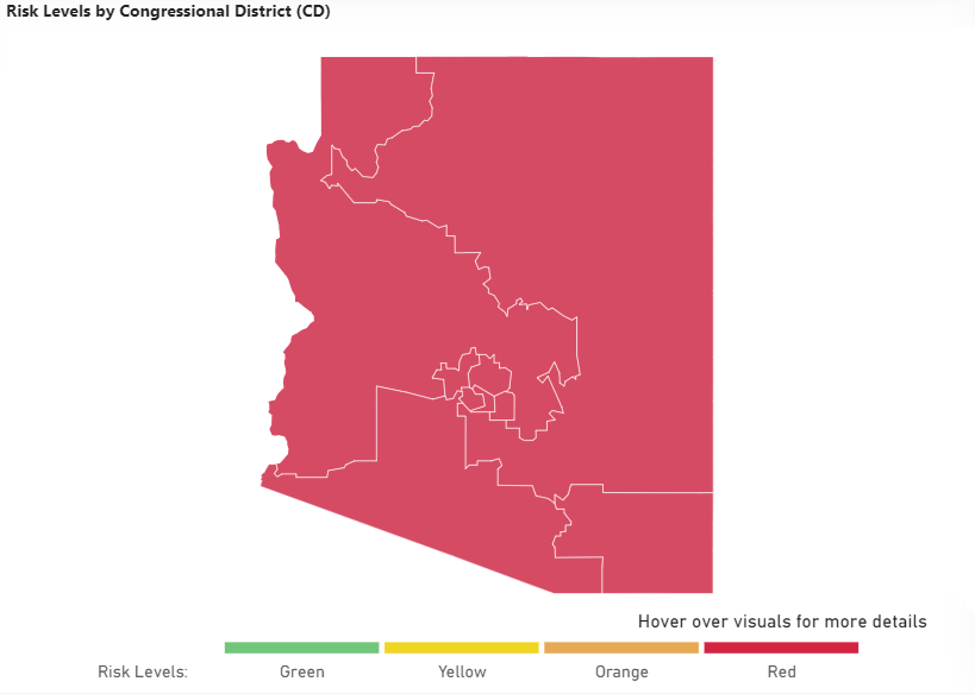
The Covid Tracking Project: www.covidtrackingproject.com
For the current Rt value (infection rate) to Rt.live.
Pima County Health Department portal: https://www.arcgis.com/apps/opsdashboard/index.html#/426baca70718453a9f63a4f85e545d8b
The national CDC site: https://www.cdc.gov/coronavirus/2019-ncov/cases-updates/index.html
For the NY Times data sets, use this link:
https://www.nytimes.com/interactive/2020/04/23/upshot/five-ways-to-monitor-coronavirus-outbreak-us.html
You can find the Harvard data on this site: Harvard Global Health Institute Key Metrics
The State Department of Health site is at this link: www.azdhs.gov.
Track the advice on public schools through this link: https://www.azed.gov/communications/2020/03/10/guidance-to-schools-on-covid-19/ You can find all the dashboard information at the “School Reopening Public Health Benchmarks” spot. And here’s the UA daily update link. www.covid.arizona.edu. When it opens, click ‘See Latest Updates’, and it’ll take you to a screen with the updated data.
Sincerely,

Steve Kozachik
Council Member, Ward 6
ward6@tucsonaz.gov

City of Tucson Resources
|